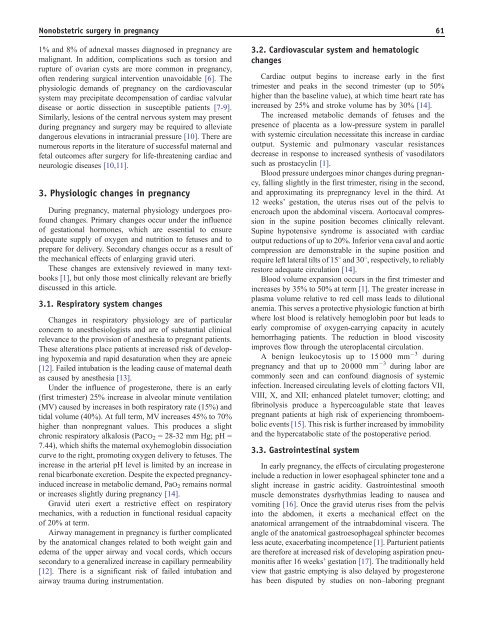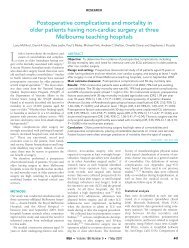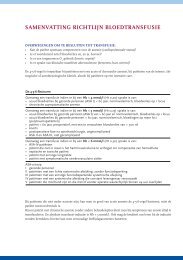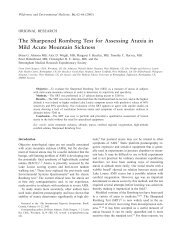Anesthesia in pregnant patients for nonobstetric ... - Ape Med Miami
Anesthesia in pregnant patients for nonobstetric ... - Ape Med Miami
Anesthesia in pregnant patients for nonobstetric ... - Ape Med Miami
You also want an ePaper? Increase the reach of your titles
YUMPU automatically turns print PDFs into web optimized ePapers that Google loves.
Nonobstetric surgery <strong>in</strong> pregnancy 61<br />
1% and 8% of adnexal masses diagnosed <strong>in</strong> pregnancy are<br />
malignant. In addition, complications such as torsion and<br />
rupture of ovarian cysts are more common <strong>in</strong> pregnancy,<br />
often render<strong>in</strong>g surgical <strong>in</strong>tervention unavoidable [6]. The<br />
physiologic demands of pregnancy on the cardiovascular<br />
system may precipitate decompensation of cardiac valvular<br />
disease or aortic dissection <strong>in</strong> susceptible <strong>patients</strong> [7-9].<br />
Similarly, lesions of the central nervous system may present<br />
dur<strong>in</strong>g pregnancy and surgery may be required to alleviate<br />
dangerous elevations <strong>in</strong> <strong>in</strong>tracranial pressure [10]. There are<br />
numerous reports <strong>in</strong> the literature of successful maternal and<br />
fetal outcomes after surgery <strong>for</strong> life-threaten<strong>in</strong>g cardiac and<br />
neurologic diseases [10,11].<br />
3. Physiologic changes <strong>in</strong> pregnancy<br />
Dur<strong>in</strong>g pregnancy, maternal physiology undergoes profound<br />
changes. Primary changes occur under the <strong>in</strong>fluence<br />
of gestational hormones, which are essential to ensure<br />
adequate supply of oxygen and nutrition to fetuses and to<br />
prepare <strong>for</strong> delivery. Secondary changes occur as a result of<br />
the mechanical effects of enlarg<strong>in</strong>g gravid uteri.<br />
These changes are extensively reviewed <strong>in</strong> many textbooks<br />
[1], but only those most cl<strong>in</strong>ically relevant are briefly<br />
discussed <strong>in</strong> this article.<br />
3.1. Respiratory system changes<br />
Changes <strong>in</strong> respiratory physiology are of particular<br />
concern to anesthesiologists and are of substantial cl<strong>in</strong>ical<br />
relevance to the provision of anesthesia to <strong>pregnant</strong> <strong>patients</strong>.<br />
These alterations place <strong>patients</strong> at <strong>in</strong>creased risk of develop<strong>in</strong>g<br />
hypoxemia and rapid desaturation when they are apneic<br />
[12]. Failed <strong>in</strong>tubation is the lead<strong>in</strong>g cause of maternal death<br />
as caused by anesthesia [13].<br />
Under the <strong>in</strong>fluence of progesterone, there is an early<br />
(first trimester) 25% <strong>in</strong>crease <strong>in</strong> alveolar m<strong>in</strong>ute ventilation<br />
(MV) caused by <strong>in</strong>creases <strong>in</strong> both respiratory rate (15%) and<br />
tidal volume (40%). At full term, MV <strong>in</strong>creases 45% to 70%<br />
higher than non<strong>pregnant</strong> values. This produces a slight<br />
chronic respiratory alkalosis (Paco 2 = 28-32 mm Hg; pH =<br />
7.44), which shifts the maternal oxyhemoglob<strong>in</strong> dissociation<br />
curve to the right, promot<strong>in</strong>g oxygen delivery to fetuses. The<br />
<strong>in</strong>crease <strong>in</strong> the arterial pH level is limited by an <strong>in</strong>crease <strong>in</strong><br />
renal bicarbonate excretion. Despite the expected pregnancy<strong>in</strong>duced<br />
<strong>in</strong>crease <strong>in</strong> metabolic demand, Pao 2 rema<strong>in</strong>s normal<br />
or <strong>in</strong>creases slightly dur<strong>in</strong>g pregnancy [14].<br />
Gravid uteri exert a restrictive effect on respiratory<br />
mechanics, with a reduction <strong>in</strong> functional residual capacity<br />
of 20% at term.<br />
Airway management <strong>in</strong> pregnancy is further complicated<br />
by the anatomical changes related to both weight ga<strong>in</strong> and<br />
edema of the upper airway and vocal cords, which occurs<br />
secondary to a generalized <strong>in</strong>crease <strong>in</strong> capillary permeability<br />
[12]. There is a significant risk of failed <strong>in</strong>tubation and<br />
airway trauma dur<strong>in</strong>g <strong>in</strong>strumentation.<br />
3.2. Cardiovascular system and hematologic<br />
changes<br />
Cardiac output beg<strong>in</strong>s to <strong>in</strong>crease early <strong>in</strong> the first<br />
trimester and peaks <strong>in</strong> the second trimester (up to 50%<br />
higher than the basel<strong>in</strong>e value), at which time heart rate has<br />
<strong>in</strong>creased by 25% and stroke volume has by 30% [14].<br />
The <strong>in</strong>creased metabolic demands of fetuses and the<br />
presence of placenta as a low-pressure system <strong>in</strong> parallel<br />
with systemic circulation necessitate this <strong>in</strong>crease <strong>in</strong> cardiac<br />
output. Systemic and pulmonary vascular resistances<br />
decrease <strong>in</strong> response to <strong>in</strong>creased synthesis of vasodilators<br />
such as prostacycl<strong>in</strong> [1].<br />
Blood pressure undergoes m<strong>in</strong>or changes dur<strong>in</strong>g pregnancy,<br />
fall<strong>in</strong>g slightly <strong>in</strong> the first trimester, ris<strong>in</strong>g <strong>in</strong> the second,<br />
and approximat<strong>in</strong>g its prepregnancy level <strong>in</strong> the third. At<br />
12 weeks’ gestation, the uterus rises out of the pelvis to<br />
encroach upon the abdom<strong>in</strong>al viscera. Aortocaval compression<br />
<strong>in</strong> the sup<strong>in</strong>e position becomes cl<strong>in</strong>ically relevant.<br />
Sup<strong>in</strong>e hypotensive syndrome is associated with cardiac<br />
output reductions of up to 20%. Inferior vena caval and aortic<br />
compression are demonstrable <strong>in</strong> the sup<strong>in</strong>e position and<br />
require left lateral tilts of 158 and 308, respectively, to reliably<br />
restore adequate circulation [14].<br />
Blood volume expansion occurs <strong>in</strong> the first trimester and<br />
<strong>in</strong>creases by 35% to 50% at term [1]. The greater <strong>in</strong>crease <strong>in</strong><br />
plasma volume relative to red cell mass leads to dilutional<br />
anemia. This serves a protective physiologic function at birth<br />
where lost blood is relatively hemoglob<strong>in</strong> poor but leads to<br />
early compromise of oxygen-carry<strong>in</strong>g capacity <strong>in</strong> acutely<br />
hemorrhag<strong>in</strong>g <strong>patients</strong>. The reduction <strong>in</strong> blood viscosity<br />
improves flow through the uteroplacental circulation.<br />
A benign leukocytosis up to 15000 mm 3 dur<strong>in</strong>g<br />
pregnancy and that up to 20000 mm 3 dur<strong>in</strong>g labor are<br />
commonly seen and can confound diagnosis of systemic<br />
<strong>in</strong>fection. Increased circulat<strong>in</strong>g levels of clott<strong>in</strong>g factors VII,<br />
VIII, X, and XII; enhanced platelet turnover; clott<strong>in</strong>g; and<br />
fibr<strong>in</strong>olysis produce a hypercoagulable state that leaves<br />
<strong>pregnant</strong> <strong>patients</strong> at high risk of experienc<strong>in</strong>g thromboembolic<br />
events [15]. This risk is further <strong>in</strong>creased by immobility<br />
and the hypercatabolic state of the postoperative period.<br />
3.3. Gastro<strong>in</strong>test<strong>in</strong>al system<br />
In early pregnancy, the effects of circulat<strong>in</strong>g progesterone<br />
<strong>in</strong>clude a reduction <strong>in</strong> lower esophageal sph<strong>in</strong>cter tone and a<br />
slight <strong>in</strong>crease <strong>in</strong> gastric acidity. Gastro<strong>in</strong>test<strong>in</strong>al smooth<br />
muscle demonstrates dysrhythmias lead<strong>in</strong>g to nausea and<br />
vomit<strong>in</strong>g [16]. Once the gravid uterus rises from the pelvis<br />
<strong>in</strong>to the abdomen, it exerts a mechanical effect on the<br />
anatomical arrangement of the <strong>in</strong>traabdom<strong>in</strong>al viscera. The<br />
angle of the anatomical gastroesophageal sph<strong>in</strong>cter becomes<br />
less acute, exacerbat<strong>in</strong>g <strong>in</strong>competence [1]. Parturient <strong>patients</strong><br />
are there<strong>for</strong>e at <strong>in</strong>creased risk of develop<strong>in</strong>g aspiration pneumonitis<br />
after 16 weeks’ gestation [17]. The traditionally held<br />
view that gastric empty<strong>in</strong>g is also delayed by progesterone<br />
has been disputed by studies on non–labor<strong>in</strong>g <strong>pregnant</strong>





